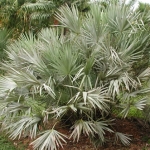| Common Name: |
Dwarf Palm |
| Other Names: |
Fan Palm, Sabal, Sabal Palm, Saw Palmetto |
| Botanical Name: |
Serenoa repens syn. S. serrulata |
| Genus: |
Serenoa |
| Family: |
Arecaceae |
| Native Location: |
SE USA (South Carolina to Florida Keys, and west to Alabama and Missouri |
| Cultivation: |
Moist to wet soil in sun or dappled shade. Plants grown under glass may be attacked by spider mites and scale insects. |
| Propagation: |
By seed sown in spring; by separation of suckers in spring. Divided clumps are difficult to re-establish. |
| Harvest: |
Fruits are collected when ripe, partly dried for elixirs, infusions, liquid extracts, and tinctures, or dried and powdered for use in tablets. |
| Height: |
2-4m (6-12ft) |
| Width: |
Indefinite |
| Hardiness: |
Min. 7°C (45°F) |
| History: |
Native Americans have long prized saw palmetto—a small evergreen palm tree indigenous to Florida and Georgia—for its ornamental beauty and its nutritional and medicinal value. Folk healers were the first to notice that animals who grazed on the shrubs tiny, blue-black fruits (berries) were extraordinarily healthy, and it wasn't long before animals and humans were both enjoying the benefits of saw palmetto. The fresh fruits are succulent, sweet, and rich in nutrients. They were traditionally prescribed to normalize digestion and strengthen the body after a debilitating illness. Decoctions and tonics made from the dried berries were used to treat colds, coughs, and genitourinary ailments, including kidney and prostate problems, and even low sex drive.
In the last five years, saw palmetto has enjoyed a resurgence in popular use and received considerable attention from the medical community. Numerous clinical studies confirm that the herb is very effective in treating benign prostatic hypertrophy (BPH)—an enlargement of the prostate gland, which is very common among men over 50. BPH is apparently caused by an accumulation of testosterone that is in turn, converted to a substance called dihydrotestosterone (DHT). DHT appears to overstimulate prostatic cell production, which results in an enlarged prostate. Saw palmetto, however, both inhibits the conversion of testosterone to DHT and promotes rapid excretion (through the urine) of any DHT present. The less DHT in your system, the more likely you will have a healthy prostate. |
| Preparation: |
Saw palmetto is available as dried berries and in capsules, powders, teas, and tinctures. Capsules are most frequently prescribed; follow the manufacturer's or your practitioner's directions. To make a decoction, add 1 teaspoon of dried berries to 1 cup of water and bring to a boil, then lower heat and simmer for 5 minutes. Drink up to 3 cups a day. |
| Parts Used: |
Fruits |
| Properties: |
A sedative, warming, tonic herb with a soapy taste and pungent, vanilla-like aroma. It affects the endocrine system, is a urinary antiseptic, diuretic, and expectorant, and is reputedly aphrodisiac. |
| Medicinal Uses: |
Internally for impotence, low sex drive, debility in elderly men, prostate conditions, cystitis, bronchial complaints associated with coldness, and wasting diseases; also to encourage breast enlargement in women. May be combined with Equisetum arvense (See, Field Horsetail) and Hydrangea arborescens (See, Wild Hydrangea) for enlarged prostate.
Saw palmetto has anti-inflammatory, antiseptic, digestive, diuretic, expectorant, nutritive, sedating, and tonic properties. It is taken internally as a general tonic and to treat asthma, benign prostatic hyperplasia (BHP), bronchitis, debilitation, colds, coughs, nasal congestion, sinus congestion, and sore throats. |
| Culinary Uses: |
Fruits and seeds are edible. |
| Caution: |
Do not self-diagnose or self-treat a suspected prostate problem, and do not take saw palmetto without first consulting your medical practitioner. The symptoms of benign prostate enlargement and prostate cancer are similar and can include urine retention, dribbling, and blood in the urine. Such symptoms should be evaluated by a physician. No serious side effects from overconsumption of the herb may include stomach upset, headaches, and diarrhea. Saw palmetto was once traditionally used to treat female infertility and to increase breast size; we do not recommend the herb for these uses. |
| Bibliography: |
Encyclopedia of Herbs by Deni Brown Copyright © 1995, 2001 Dorling Kindersley Limited Pg 367
The Modern Herbal Primer by Nancy Burke Copyright©2000 pp. 126-127 |

